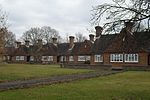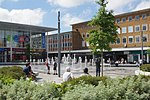Ancient Priors

The Ancient Priors is a medieval timber-framed hall-house on the High Street in Crawley, a town and borough in West Sussex, England. It was built in approximately 1450, partly replacing an older (probably 14th-century) structure—although part of this survives behind the present street frontage. It has been expanded, altered and renovated many times since, and fell into such disrepair by the 1930s that demolition was considered. It has since been refurbished and is now a restaurant, although it has been put to various uses during its existence. Secret rooms, whose purpose has never been confirmed for certain, were discovered in the 19th century. English Heritage has listed the building at Grade II* for its architectural and historical importance, and it has been described as Crawley's "most prestigious medieval building" and "the finest timber-framed house between London and Brighton".
Excerpt from the Wikipedia article Ancient Priors (License: CC BY-SA 3.0, Authors, Images).Ancient Priors
High Street,
Geographical coordinates (GPS) Address Nearby Places Show on map
Geographical coordinates (GPS)
| Latitude | Longitude |
|---|---|
| N 51.1139 ° | E -0.1903 ° |
Address
High Street
RH10 1BN
England, United Kingdom
Open on Google Maps











